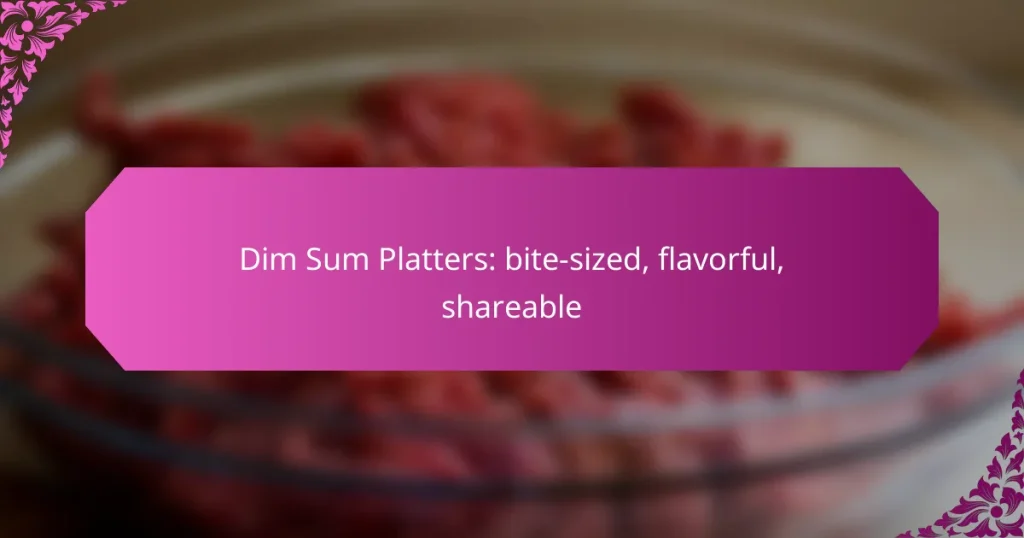Dim sum platters are a culinary delight, featuring an array of bite-sized, flavorful dishes that are perfect for sharing. These small portions, often steamed or fried, invite diners to explore a variety of tastes and textures, making them an ideal choice for gatherings. Selecting the right platter can enhance the dining experience, ensuring that every guest finds something to enjoy.

What are the best dim sum platters in London?
The best dim sum platters in London offer a delightful selection of bite-sized, flavorful dishes perfect for sharing. Renowned restaurants provide a variety of options, each with unique flavors and presentations that cater to different tastes.
Yauatcha dim sum platter
Yauatcha is famous for its modern take on traditional dim sum, featuring a vibrant platter that includes a mix of steamed and fried dumplings. The selection often includes options like har gau (prawn dumplings) and siu mai (pork dumplings), served alongside flavorful dipping sauces.
When ordering the Yauatcha dim sum platter, consider trying their signature dishes, which are crafted with high-quality ingredients. The atmosphere is chic, making it a great spot for both casual dining and special occasions.
Hakkasan dim sum selection
Hakkasan offers a luxurious dim sum selection that combines traditional flavors with contemporary presentation. Their platter typically features a variety of dumplings, including black truffle dumplings and crispy prawn rolls, all served in an elegant setting.
For the best experience, pair the dim sum with one of Hakkasan’s signature cocktails or premium teas. Reservations are recommended, especially during peak dining hours, to ensure you secure a table in this upscale environment.
Dim T dim sum offerings
Dim T specializes in a diverse range of dim sum offerings, emphasizing fresh ingredients and authentic flavors. Their platters include a mix of steamed buns, dumplings, and spring rolls, providing a satisfying variety for diners.
To enhance your meal at Dim T, consider sharing several platters among friends or family, allowing everyone to sample different dishes. The casual atmosphere makes it an ideal spot for a relaxed dining experience, and prices are generally reasonable compared to other high-end establishments.

How to choose the right dim sum platter for a gathering?
Selecting the right dim sum platter for a gathering involves understanding your guests’ tastes, dietary needs, and the quantity required. A well-chosen platter enhances the dining experience and ensures everyone enjoys the meal.
Consider guest preferences
Understanding your guests’ preferences is crucial when choosing a dim sum platter. Consider whether they enjoy savory or sweet options, and if they prefer meat, seafood, or vegetarian dishes. Popular choices include dumplings, buns, and rolls, which can cater to diverse tastes.
To make the selection process easier, you might create a small survey or ask guests directly about their favorite dim sum items. This approach can help you tailor the platter to maximize enjoyment.
Assess dietary restrictions
When selecting a dim sum platter, it’s essential to consider any dietary restrictions among your guests. Common restrictions include vegetarian, vegan, gluten-free, and nut allergies. Many dim sum options can be modified to accommodate these needs.
For instance, steamed vegetable dumplings can be a great choice for vegetarians, while rice paper rolls are often gluten-free. Always check with your guests beforehand to ensure you provide suitable options.
Evaluate portion sizes
Evaluating portion sizes is key to ensuring that everyone has enough to eat without excessive leftovers. A good rule of thumb is to plan for about 3-5 pieces of dim sum per person, depending on the variety and other dishes served.
Consider the overall size of your gathering and the length of the event when determining how many platters to order. If you’re serving multiple courses, you may want to reduce the number of dim sum pieces per guest. Always err on the side of having a little extra, as dim sum is often a crowd favorite.

What are the popular types of dim sum?
Popular types of dim sum include a variety of bite-sized dishes that are often steamed or fried, making them flavorful and shareable. These dishes are typically served in small portions, allowing diners to sample multiple items in one meal.
Siu mai (pork dumplings)
Siu mai are open-topped dumplings filled with a mixture of ground pork, shrimp, and seasonings. They are usually garnished with a small piece of carrot or green pea on top, adding a pop of color and flavor.
When ordering siu mai, look for those that are freshly steamed, as they should have a tender yet slightly chewy texture. They are often served with soy sauce or chili oil for added taste.
Har gow (shrimp dumplings)
Har gow are delicate dumplings made with a translucent rice flour wrapper filled with fresh shrimp. Their signature feature is the pleated design, which not only looks appealing but also helps to keep the filling intact during cooking.
To enjoy har gow at their best, consume them while they are still hot. A good har gow should have a slightly chewy wrapper and a juicy, flavorful shrimp filling. Pair them with a light soy sauce or vinegar for a refreshing contrast.
Char siu bao (BBQ pork buns)
Char siu bao are fluffy steamed buns filled with sweet and savory barbecued pork. These buns can be found in both steamed and baked varieties, with the steamed version being particularly soft and pillowy.
When selecting char siu bao, check for a well-balanced filling that is not overly sweet. The buns should be soft to the touch and have a slightly glossy exterior. They are often enjoyed as a hearty snack or part of a larger dim sum meal.

How are dim sum platters typically served?
Dim sum platters are usually served in a communal style, allowing diners to share a variety of bite-sized dishes. This approach encourages social interaction and makes it easy to sample different flavors and textures.
Steamed in bamboo baskets
One of the most traditional methods of serving dim sum is in bamboo steamers. These baskets allow for even steaming, preserving the moisture and flavor of the dumplings and buns. They are often stacked on top of each other, creating a visually appealing presentation.
When ordering, expect to see a range of items such as siu mai (pork dumplings) and har gow (shrimp dumplings) served in these baskets. Each basket typically contains a small number of pieces, making it easy to share among diners.
Served with dipping sauces
Dipping sauces are an essential accompaniment to dim sum, enhancing the flavors of the dishes. Common sauces include soy sauce, chili oil, and vinegar-based dips, each offering a unique taste experience. Diners can mix and match sauces to find their preferred combinations.
When enjoying dim sum, it’s advisable to try a small amount of each sauce with different dishes to discover which pairings work best for your palate. This adds an interactive element to the meal.
Accompanied by tea
Tea is traditionally served alongside dim sum, complementing the meal and aiding digestion. Popular choices include jasmine, oolong, and pu-erh tea, each bringing distinct flavors that enhance the overall dining experience.
When selecting tea, consider the strength and aroma that best match the dishes you are enjoying. A light tea can refresh the palate, while a stronger brew may stand up well to richer flavors. It’s common to refill tea cups throughout the meal, promoting a relaxed atmosphere.

What are the key ingredients in dim sum?
The key ingredients in dim sum include a variety of doughs, meats, seafood, and vegetables, all designed to create bite-sized, flavorful dishes. These components come together to form a diverse range of textures and tastes, making dim sum a popular choice for sharing among groups.
Wheat flour for dumpling wrappers
Wheat flour is the primary ingredient used to create dumpling wrappers, which serve as the foundation for many dim sum dishes. The flour is typically mixed with water to form a smooth dough, which is then rolled out and cut into circles for filling. The thickness of the wrappers can vary, affecting the final texture and taste of the dumplings.
When making dumplings, consider using high-gluten flour for a chewier texture or all-purpose flour for a softer bite. Aim for a dough that is pliable yet firm enough to hold the filling without tearing.
Various meats and seafood
Dim sum features a wide range of meats and seafood, which provide rich flavors and protein. Common choices include pork, chicken, shrimp, and beef, often seasoned with soy sauce, ginger, and garlic. These ingredients can be steamed, fried, or baked, each method imparting a unique taste and texture.
When selecting meats or seafood for dim sum, ensure freshness and quality. For example, use fresh shrimp for a bouncy texture and flavorful pork for a savory filling. Consider marinating meats to enhance their flavors before cooking.
Vegetables and seasonings
Vegetables play a crucial role in dim sum, adding color, crunch, and nutritional value. Common vegetables include bok choy, mushrooms, and carrots, which can be used as fillings or side ingredients. Seasonings such as sesame oil, soy sauce, and scallions are essential for enhancing the overall flavor profile.
When incorporating vegetables, aim for a balance between flavors and textures. For instance, combine crunchy vegetables with tender meats to create a harmonious bite. Always wash and prepare vegetables properly to maintain their freshness and taste in the final dish.

What are the benefits of ordering dim sum platters?
Ordering dim sum platters offers a variety of bite-sized, flavorful dishes that are perfect for sharing. These platters encourage social dining and allow you to sample multiple flavors in one meal, making them an excellent choice for gatherings or casual meals.
Variety of Flavors
Dim sum platters typically include a diverse selection of dishes, such as dumplings, buns, and rolls, each with unique flavors and textures. This variety allows diners to explore different culinary experiences within a single meal. For example, you might find steamed shrimp dumplings alongside pork buns and vegetable spring rolls.
Social Dining Experience
Sharing dim sum platters fosters a communal dining atmosphere, making meals more enjoyable and interactive. Diners can pass around dishes, encouraging conversation and connection. This style of eating is particularly popular in cultures where food is a central part of social gatherings.
Portion Control
Dim sum platters provide an opportunity for portion control, as each item is typically small and manageable. This allows diners to enjoy a variety of foods without overeating. You can easily select a few pieces of each dish, which helps maintain a balanced meal while still indulging in different flavors.
Cost-Effective Dining
Ordering dim sum platters can be a cost-effective way to enjoy a meal, especially when dining with a group. Instead of ordering individual entrees, sharing a platter can reduce overall costs while providing a more extensive selection of dishes. This approach is particularly beneficial in restaurants that offer dim sum at reasonable prices, often ranging from $20 to $50 per platter, depending on the number of items included.

